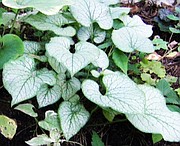Mossy habitat can support bevy of ornamentals
VALLE NOVAK Contributing Writer | Bonner County Daily Bee | UPDATED 4 years AGO
Depending on individual property sites in our high-county North Idaho surroundings, area residents generally share an acidic soil situation — conducive to moss.
Hills and mountains, rocky terrain, lakes and waterways and the plethora of trees, shrubs and groundcover all contribute to this. Small home-owners and gardeners generally don’t have too much of a problem, since the installation of ornamental and/or vegetable gardens necessitates digging up and enriching or replacing soil to accept what’s to be planted. Too, raised beds and/or pot-planting can be an option.
Large-scale landscaping does not pose much of a problem, especially if native and/or wild trees and shrubs — or their cultivars are used. But “native’ is the keyword here. However, many people — including those from other areas — prefer perennials and annuals which prefer alkaline soils. Amendment of soil in a small garden space is doable but in larger areas the cost — and effort — can be major and to me, unnecessary.
My decades of living with (and loving) moss has made me a true aficionado of its positive aspects. Aside from the fact it is pretty, generally weed-free and welcoming to some very special garden ornamentals. These include Foxglove, Monkshood; Columbine; Brunnera; Bleeding heart; Tiarella (foam flower); Coral bells; Hosta; Ferns; Hellebore; Lilies of the Valley; Oriental Iris; Pulmonaria (lungwort); and a host of natives such as Dewberry, Bloodroot, Solomon’s seal, Trillium, Turk’s cap lily, Sweet Autumn Clematis, and many more. They all grow happily in the mossy soil. If there are extant mossy rocks and fallen logs, so much the better — they make for gorgeous backdrops as well as spots for tuck-in plantings.
Small or large, a moss garden can be made special. A fabulous rhododendron or azalea with a birdbath or lawn chair can make a little niche enchanting. Since moss gardens don’t generally offer the option of strolling or sitting in them, — the moss itself is part of the growing beauty — ornaments from gazing balls to urns or statues can be displayed, and a flagstone path can be artfully created to lead to a garden bench or other focal point.
Now, extolling the beauties of a mossy garden doesn’t mean there are no problems. We all know that the afore-mentioned Hosta is a beacon for deer and slugs as well. A few years back I realized how to deter them both without harming the moss: Blood meal. As well as being a good all-around soil nourisher, it not only deters slugs, but deer, rabbits and raccoons — (as well as the neighborhood dogs!)
In my case, deterring deer is as important as anything, though in deep snow season, I toss cut-up apples and carrots to them — but they didn’t seem to realize that my flowers are not dessert, until I discovered the blood meal.
By the way, while nearly everything listed above is spurned by deer, they do relish Hosta and Coral bells in particular. When I decided to replace them with Brunnera to offput the deer, it was like a revelation! For several years now, all my listed beauties have thrived — and I give blood meal the credit. I hope my experiences with a mossy environment have helped somewhat with others struggling to cope with it. But please realize it doesn’t just take “coping” — it takes understanding — and appreciation of just how lovely and rewarding it can be.
If you ever have questions or remarks please feel free to call me anytime from 8 a.m. to 6 p.m. at 208-265-4688. I’d love to hear from you.
Valle Novak writes the Country Chef and Weekend Gardener columns for the Daily Bee. She can be reached at [email protected] or by phone at 208-265-4688 between the hours of 8 a.m. to 7 p.m.





